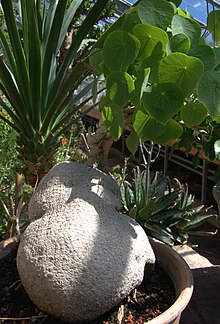Stephania (genus)
| Stephania | ||||||||||||
|---|---|---|---|---|---|---|---|---|---|---|---|---|

Stephania Delavayi |
||||||||||||
| Systematics | ||||||||||||
|
||||||||||||
| Scientific name | ||||||||||||
| Stephania | ||||||||||||
| Lour. |
Stephania is a plant kind from the family of menispermaceae (Menispermaceae).
description
Vegetative characteristics
Stephania species grow as climbing woody or herbaceous plants ( lianas ). Tuberous roots are formed that can sometimes be seen above the ground. They're a bit squirming. The alternate and spirally arranged leaves are divided into a petiole and a leaf blade. The often very long petioles are swollen at both ends. The herbaceous, rarely membranous or slightly leathery leaf blades are simple, more or less deltoid or peltate and pinnate. The leaf margin is smooth. Stipules are missing.
Generative characteristics

Stephania species are dioecious separate sexes ( diocesan ). Lateral or on branches, seldom from the trunk, mostly umbel-like, zymous , sometimes capricious or rarely thyrsoid inflorescences develop .
The mostly stalked, unisexual flowers are usually small, inconspicuous and three to four-fold. The male flowers have: usually two, rarely a symmetrical circle of three or four sepals , which are fused at most at the base; three or four petals each in usually one, rarely two circles or they are seldom missing; there are usually four (two to six) fertile stamens that are fused with the petals. The female flowers have: each a symmetrical circle of three to four sepals and petals or asymmetrically one (or two) sepals and two (or three) petals, whereby the petals can be green, white or yellow; an almost ovate, free carpel ; Staminodes are absent. Only one of the two ovules develops.
The red or orange-red ripening stone fruit is almost spherical, 4 to 6 mm long and slightly flattened on both sides with stigmas of the style at their base. The horseshoe-shaped seeds have a fleshy endosperm and a horseshoe-shaped embryo.
The base chromosome numbers determined only for some species are n = 11, 12, 13.
distribution
They thrive from the tropics to the subtropics. Most of the approximately 60 species occur in tropical Asia. There are some species in Africa and a few in Oceania . There are 37 species in China, 30 of them only there.
Systematics

The genus Stephania belongs to the tribe Menispermae in the family of menispermaceae (Menispermaceae). The valid first publication comes from João de Loureiro in Flora Cochinchinensis , Volume 2, 598, 608, 1790. A homonym is Stephania Willd. published in Species Plantarum , Editio quarta, 2, 1, 1799, p. 239. Synonyms are Clypea Blume , Echinostephia (Diels) Domin , Perichasma Miers . The genus name Stephania honors the German-Russian botanist Christian Friedrich Stephan (1757–1814).
There are about 60 types (selection):
use
They contain over 50 different alkaloids. Drugs from the tuberous roots are used in traditional Chinese medicine and as local medicine. It is often used as a fish poison .
swell
- Qiming Hu, Xianrui Luo, Tao Chen & Michael G. Gilbert: Menispermaceae in der Flora of China , Volume 7, 2008, p. 15: Stephania - Online. (Section description, system, distribution and use.)
- B. Richardson, 2008: Stephania in the Western Australian Flora Online. (Section description)
- K. Kubitzki, JG Rohwer, & V. Bittrich: The Families and Genera of Vascular Plants. II Flowering Plants. Dicotyledons - Magnoliid, Hamamelid and Caryophyllid Families. , Berlin Heidelberg New York: Springer, 1993. Stephania on p. 415.
Individual evidence
- ↑ João de Loureiro : Flora Cochinchinensis . tape 2 , 1790, p. 598, 608 (Latin, biodiversitylibrary.org [accessed July 26, 2019]).

